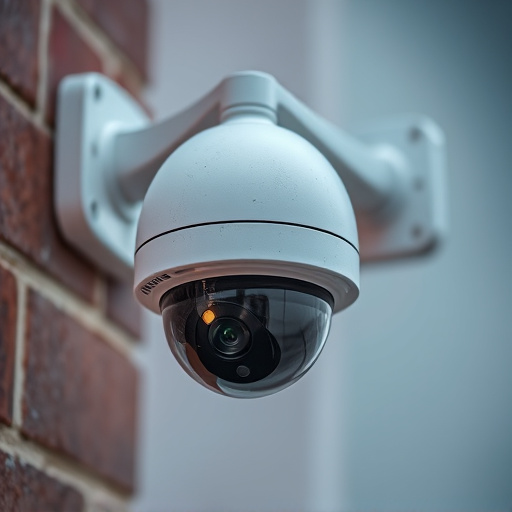Optimal fake security camera height placement is at eye level or slightly elevated for realism and effectiveness. This strategy combines clear vision with discreetness, deterring thieves without disrupting the shopping experience. A multi-layered system involving ceiling/wall cameras and ground-level cameras in high-risk areas creates a powerful psychological deterrent. Balanced distribution throughout the store, including corners and high-theft zones, enhances security presence and reduces shoplifting incidents. Regular position changes maximize the deterrent effect of fake security camera height placement.
Retail stores are always seeking effective security solutions without breaking the bank. Mock security cameras, also known as fake or decoy cameras, offer a cost-efficient alternative to real surveillance systems. This article guides you through choosing the optimal height for these decoys and provides strategic placement tips for maximum deterrence. We’ll explore the numerous benefits of employing mock cameras in retail settings and share best practices to ensure effective store surveillance without the hefty price tag.
- Choosing the Right Height for Fake Cameras
- Placement Strategies for Maximum Deterrence
- Benefits of Using Mock Security Cameras
- Best Practices for Retail Store Surveillance
Choosing the Right Height for Fake Cameras
When placing mock security cameras in retail stores, one crucial consideration is the camera’s height. The optimal location for fake cameras is typically eye-level or slightly elevated. This strategic placement ensures a comprehensive view of the store while maintaining a natural appearance. If cameras are placed too low, they might go unnoticed by genuine shoppers, defeating their purpose as deterrents. Conversely, positioning them too high can make them look out of place and reduce their effectiveness as visual aids for security personnel.
The ideal height allows the cameras to capture clear footage without appearing overly intrusive or obvious. This balance is essential in creating a realistic simulation that enhances store security without significantly impacting the shopping experience. By strategically choosing the right height, retailers can effectively deter potential thieves while maintaining an aesthetically pleasing environment.
Placement Strategies for Maximum Deterrence
The strategic placement of mock security cameras is key to enhancing retail store security. To maximize deterrent effect, cameras should be positioned at various heights and angles. Mounting them high on walls or ceilings can create an illusion of all-encompassing surveillance, deterring potential thieves from even attempting theft. However, ground-level cameras strategically placed near high-theft areas like entrances, exits, or merchandise displays, serve as a powerful visual reminder to shoppers. Combining these approaches creates a multi-layered security system that significantly discourages criminal activity.
Additionally, the use of realistic fake security cameras can be augmented by incorporating various mounting techniques. Cameras on tripods or stands draw attention and mimic live camera operations, while hidden cameras disguised as decorative items or fixtures offer an element of surprise. The diversity in height placement, from high-up to ground-level, coupled with different visual presentations, reinforces the stores’ security presence, acting as a powerful psychological deterrent.
Benefits of Using Mock Security Cameras
Mock security cameras offer a multitude of benefits for retail stores looking to enhance their security and deter theft. One of the key advantages is their strategic placement, often at varying heights, including on ceilings or in corners. This ‘fake’ camera height placement misleads potential thieves, creating the illusion of constant surveillance throughout the store. The visual deterrent alone can significantly reduce shoplifting incidents.
Furthermore, these cameras provide peace of mind for both employees and business owners by serving as a powerful psychological tool. Their presence encourages honest behavior and can act as a backup system alongside real security personnel. With advanced technology, mock cameras can also be integrated into broader surveillance systems, offering stores a comprehensive security solution that combines physical deterrents with digital monitoring.
Best Practices for Retail Store Surveillance
To maximize the effectiveness of mock security cameras, retailers should adhere to best practices in surveillance. One crucial aspect is strategic height placement. Fake security cameras should be positioned at eye level or slightly above, mimicking real camera locations. This tactic not only appears authentic but also discourages potential thieves, as it creates the perception of constant observation.
Additionally, a balanced distribution of these mock cameras throughout the store is essential. While high-risk areas like entrances and exits, jewelry displays, and cash registers should have an increased camera density, ensuring every aisle and corner is covered conveys a strong security presence. Regularly changing the positions of the fake cameras can further enhance their deterrent effect.
Mock security cameras, strategically placed at optimal heights and locations, offer retailers an affordable and effective deterrent against theft. By understanding the best practices for height placement and camera positioning, store owners can enhance their loss prevention strategies. These fake cameras send a clear message to potential thieves, acting as a powerful visual reminder that every move is monitored. With the right approach, retail stores can create an environment that discourages unethical behavior while providing genuine peace of mind.
